Office-Related Activities and Results
Current Environmental Impact
Funai Electric's headquarters is promoting environmental preservation activities aimed at making effective use of resources and energy, reducing waste and increasing the recycling ratio. To this end, we analyze the amount of resources and energy taken in (inputs), waste and other products emitted (outputs) and amounts recycled.
In fiscal 2011, we achieved zero emissions in terms of waste generated.
■Environmental Impact

| Input | Output | ||
|---|---|---|---|
| Electricity | Purchased electricity used within headquarters | CO2 | Carbon dioxide generated through the use of electricity, gas and gasoline |
| Gas | Used at headquarters cafeteria | Recycling | Waste generated through business activities that can be used as other resources and incinerated for thermal recycling (used for power generation) |
| Gasoline | Used by Company vehicles at headquarters | ||
| Water Supply | Used at headquarters lavatories and other facilities | ||
| OA Paper | Paper used for copying and printing within headquarters | ||
Content of Activities and Annual Performance Trends
Amount of Electricity Used
We are working to reduce carbon dioxide (CO2). At worksites in Japan, we mainly use electricity. We are working to promote education for our employees about energy-conserving activities and energy conservation through efforts such as cool-biz/warm-biz (encouraging employees to wear lighter clothing in summer and heavier clothing in winter). As a result, in fiscal 2014 electricity consumption decreased by 19million kWh compared to fiscal 2013.
■Electricity Use

Initiatives Related to Energy Conservation in Fiscal 2014
| Initiatives (Principal) |
|---|
|
1. Reduction of gas consumption by reviewing the setting temperature of all gas water heaters in cafeteria |
|
2. Installation of the shading net at 26 air-conditioner outdoor units on roof floor |
|
3. Contorol temperature of air-conditioner, cool-biz/warm-biz, All light-off at lunch time, etc |
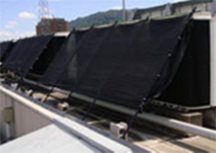 Shading net of air-conditioner outdoor unit
Shading net of air-conditioner outdoor unit
Gas Use
We use all gas to boil hot water in headquarters. In fiscal 2014, we achieved 5.5% reduction of gas comsuption compared to fiscal 2013 by reviewing the setting temperature of the gas water heaters.
Water Supply Used
We are working to conserve water as part of our efforts to use water resources effectively and reduce energy.
In fiscal 2014, water use totaled 1,517 cubic meters. We achieved 5% reduction compared to fiscal 2013.
Annual Carbon Dioxide Emissions
As a result of business activities in headquarters , we generated 1,681tons of CO2 in fiscal 2014. We decreased by 5% compared to fiscal 2013.
■Carbon Dioxide Emissions
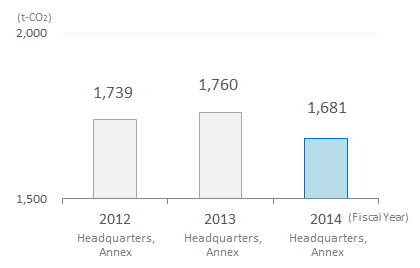
Zero Emission Initiatives
Achieving Zero Emissions
Between fiscal 2007 and fiscal 2010, we worked to improve our waste recycling ratios and move toward zero emissions. As a result of these activities, we achieved zero waste emissions in August 2011.
List of Recycled Items
Chemicals, Dry Cell Batteries, Fluorescent Bulbs, Cardboard, Paper
Televisions, Personal Computers, Wooden Pallets, Cans, Bottles, PET Bottles
Waste Oil, Expanded Polystyrene, Metal Waste, Plastic Waste
Electrical Appliances Outside the Electric Appliance Recycling Act, Prototype Products, Old Measuring Instruments, General Waste, Cafeteria Food Scraps
General waste, leftover cafeteria beverages
| History of Waste Recycling | |
|---|---|
| Before 2005 | Recycling of Cardboard, Paper, Batteries, Fluorescent Bulbs, Waste Chemicals, Empty Beverage Containers, Televisions, Personal Computers, End-of-Life Electric Appliances |
| May 2005 | Recycling of Waste Oil for Food |
| Dec. 2006 | Recycling of Expanded Polystyrene |
| Mar. 2007 | Recycling of Metal Waste |
| Jun. 2007 | Recycling of Wooden Pallets, Old Measuring Instruments |
| Feb. 2008 | Recycling of Waste Plastic |
| Jun. 2008 | Recycling of End-of-Life Electrical Appliances Outside the Electric Appliance Recycling Act, Prototype Products |
| Jul. 2009 | Recycling of Waste Plastic, Industrial Waste |
| Aug. 2011 | Recycling of General Waste, Cafeteria Food Scraps Attainment of Zero Waste Emissions |
| Oct. 2012 | Change from Thermal Recycling of Waste Plastic to Chemical Recycling |
Recycling of Wooden Pallets
We began recycling wooden pallets in fiscal 2007. Our business partners convert discarded wooden pallets into fertilizer or wood chips that are processed and reused as recycled boards.
In fiscal 2014, we recycled 6,330kg of wooden pallets.
 Wooden pallets
Wooden pallets
 Wood chips
Wood chips
 Recycled boards
Recycled boards
Paper Recycling (Cardboard, Paper)
Through paper recycling, we aim to make effective use of resources. We send Disused Cardboard, Copy Paper, Newspapers and Magazines to a recycling company for processing.
■Paper Recycling
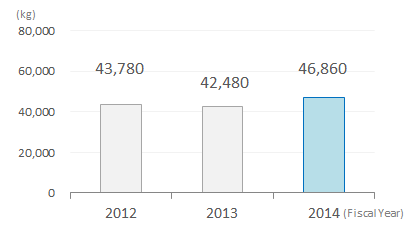
Recycling of Expanded Polystyrene
We began recycling expanded Polystyrene in December 2006. In fiscal 2014, we recycled 1,540kg, commencing material recycling into Plastic Products.

Recycling of Metal Waste
We began recycling metal waste in fiscal 2007. In fiscal 2014, we used material recycling to process 14 tons, converting it into New Parts.
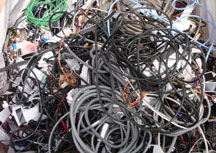
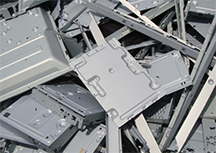
Recycling of Waste Plastic, Industrial Waste
In July 2009, we changed our method for handling waste plastic and industrial waste from simple incineration to thermal recycling. In October of fiscal 2012 we changed our method of recycling waste plastic from thermal recycling to chemical recycling. Waste plastic emissions in fiscal 2014 were 18 tons, which was all chemically recycled.
■Industrial Waste and Waste Plastic
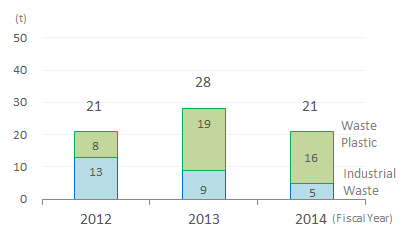
Reducing General Waste
In fiscal 2014, as the results of promotion of recycling waste plastic, the amount of general waste decreased by 20% compared to fiscal 2013.
■General Waste
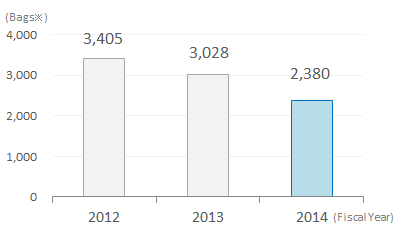
note Using 45L Trash Bags
Other Initiatives
Environmental Training Related to Worksite Activities
Funai Electric periodically conducts environmental education to make employees aware of its environmental policies and activities and to entrench environmental activities.
| Type of Training | Timing | Trainees | Content |
|---|---|---|---|
| New Employee Training | When joining the Company | All new employees | Overview of ISO 14001 and content of activities |
| General Training | Six times per year | All employees | Materials prepared by the ISO 14001 secretariat |
| Specialized Training | Once per month | Mainly engineers | Materials prepared by the Product Environment Committee |
| Study Course for Promotion Committee Members | Once per year | ISO 14001 Promotion Committee members | Materials prepared by the instructor |
Extending the Cool-Biz Period and Promoting Energy-Conserving Activities
We first introduced Cool-Biz in fiscal 2010, with the period lasting from the end of the Golden Week holidays in May through the end of October. Furthermore, beginning in fiscal 2011, for the three-month June—September period we shifted to "Super Cool Biz," defined by Japan's Ministry of the Environment as “living comfortably with room temperatures of 28℃.

